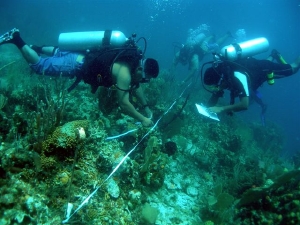Apr 28 2008
A new study supported by Earthwatch, the international environmental charity, reveals that hurricanes and storms limit the ability of corals in Belize to recruit new coral into their communities.
 Earthwatch scientists study corals of Belize. (Credit to James Crabbe)
Earthwatch scientists study corals of Belize. (Credit to James Crabbe)
“Increasing evidence now shows that storms are becoming more intense due to climate change,” said lead author and Earthwatch scientist Professor James Crabbe from the University of Bedfordshire. Coral reefs — which can grow to be thousands of years old — form and grow when free-swimming coral larvae in the ocean attach to rocks or other hard surfaces and begin to develop. Intense storms can wipe out this recruitment process.
“Storms therefore threaten the survival of the entire reef itself,” said Crabbe, who found similar results in another Earthwatch-supported study in Jamaica a few years ago. The new study will appear in the May issue of Marine Environmental Research.
“If the storms don’t destroy corals outright, they render them more susceptible to disease and that is certainly apparent on the Belize reefs,” said Crabbe, who is doing a lecture tour related to this work throughout 2008, deemed International Year of the Reef by the International Coral Reef Initiative (ICRI).
The study holds implications for marine park managers. Crabbe explains, “They may need to assist coral recruitment and settlement [in hurricane years] by establishing coral nurseries and then placing larvae in the reef at discrete locations or by setting up artificial reef blocks to help the corals survive.”
Crabbe conducted the research in 2006 and 2007 with Edwin Martinez, Earthwatch Field Director in Belize and co-author, with help from young local scientists and Earthwatch volunteers.
The team measured the size of more than 520 non-branching coral mounds in two major coral reef areas in southern Belize: the Sapodilla Cayes Marine Reserve, a world heritage site, and the Port Honduras Marine Reserve. In addition to providing habitat for an array of marine life, corals buffer coastal zones from erosive wave energy.
Crabbe’s team determined the surface area covered by the corals and entered the growth rates of the corals into a computer model to determine when in history the coral colonies first settled. They compared that with hurricane and storm data and as predicted, coral recruitment was much lower during storm years.
“The rapid growth of the tourism industry in Belize over the past five years tops the list of threats to the corals and agricultural runoff is a close second”, explains Martinez. “This study makes it clear that climate change is moving quickly up the list.”